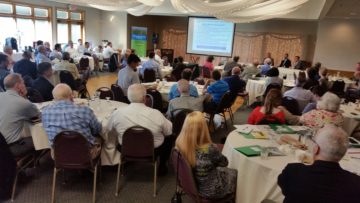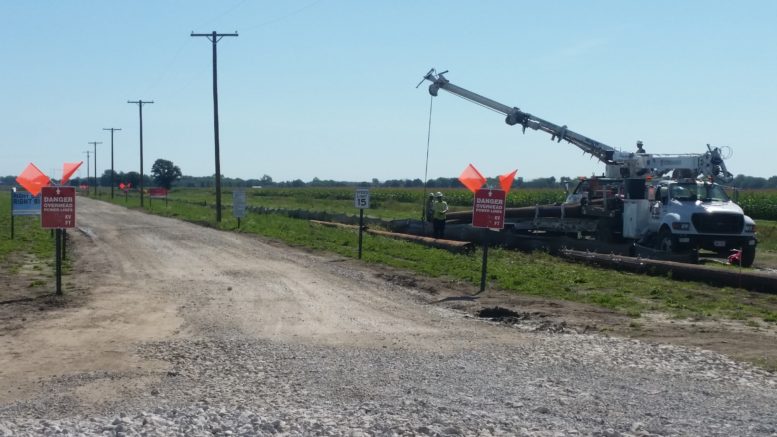By JAN LARSON McLAUGHLIN
BG Independent News
Ohio may be the nation’s leading solar manufacturer, but some state leaders’ attitudes about solar are back in the dark ages, according to Bill Spratley, executive director of Green Energy Ohio.
However, Bowling Green could be a “game changer” – building the largest solar field in the state. “Next year, Bowling Green, Wood County will be the mecca.” It’s appropriate that Bowling Green take the lead, Spratley said, since the city was the first to erect utility scale wind turbines in 2003.
Maybe the Bowling Green solar field can convince politicians that harnessing the power of the sun is no longer radical. “They still think solar is out in the future. Solar is here now,” Spratley said. “We’ve got to get past these buggy whip manufacturers.”
Spratley said he runs into solar investors around the country, curious about Ohio’s reluctance to support solar power. “What the hell is happening in Ohio,” he said they ask him.
The state legislature has frozen Ohio’s Renewable Portfolio Standard, he said. Consequently, renewable energy comprises just 3 percent of the overall mix of electricity sources in the state.
“We need to send a message to free the hostages in Columbus,” he said of possible solar funding to “get power to the people.”
Spratley was one of many speakers at the “Building Big Solar Across Ohio” conference in Bowling Green on Thursday. He was joined by leaders of renewable energy companies, representatives of solar companies, officials from communities using solar power, and green energy advocates.

Solar conference Thursday in Bowling Green
Solar power used to be “for off-the-wall hippies,” said David Dwyer, president of American Renewable Energy. But that is no longer the case.
For those unable to access solar power on their roofs, community solar was created, according to Mark Wilkerson, of Clean Energy Collective.
“Solar had to transcend politics,” said Wilkerson, who has worked in the solar industry for more than three decades. “It’s the extension of the American dream.”
And it is working in some areas. Take the small town of Minster, with just 2,850 people. It was formerly famous for its Oktoberfest and winning sports titles. But now it’s also on the map for its 18-acre solar field which produces 4.2 MW of electricity.
The conference pointed out the top 25 solar sites in Ohio, with the greatest number being in Southwest Ohio, and the greatest capacity in Northwest Ohio, including sites in Clyde and Owens Corning in Toledo. The fewest solar sites are found in the Southeast quadrant of the state.
All but one of Ohio’s 88 counties – Noble County – has some solar power generation in place.
The 25 sites together produce 132 MW of electricity – the equivalent of taking 15,000 cars off the road, according to Emily Sautter, of Green Energy Ohio.
By the end of this year, Bowling Green’s solar array should be producing 20 MW on 165 acres northeast of the city, at Carter and Newton roads. The acreage was formerly rented out for farming by the city, and will be leased at $1 a year by NextEra, which is building the solar array.
The benefits of solar power to the city include reduced carbon emissions, a more diverse power supply with peaking resources, and a fixed price for the life of the contract lasting 20 to 30 years, according to Bowling Green Utility Director Brian O’Connell.
Bowling Green has contracted for 13.7 MW from the solar site, O’Connell said. The remaining power will be purchased by other American Municipal Power members. NextEra will own and operate the site, and will sell the power to AMP, which will coordinate the power delivery and make sure Bowling Green gets its share.
Harry Phillips, of AMP, was asked why his entity was willing to take a chance on solar when others aren’t. “Our reason for jumping into solar? Beyond being a great renewable, it’s very, very functional,” he said.
The Bowling Green solar field will have 85,000 solar panels.
“That’s a lot of solar panels,” Phillips said.
The panels will have trackers, which means they will move with the sun as it crosses the sky. Consequently, the solar array can generate power earlier and later in the day, according to Matt Handel, of NextEra Energy.
The downside of tracker panels is they cost more and require more land. The rule of thumb used to be that trackers made sense west of the Mississippi River, but not in the east. That is no longer the case, since the price for tracking systems is now lower, Handel said.
Work has already begun on the Bowling Green solar field, with the project to be in operation by the end of the year.
NextEra is careful about its neighbors, with a realization that once the life of the solar field is complete, the acreage will go back to agriculture, Handel said.
“We need to be a good neighbor,” he said. “We try not to ruffle any feathers.”
The solar field has more in common with farming than some may think, Handel said. “We’re harvesting sun.”

